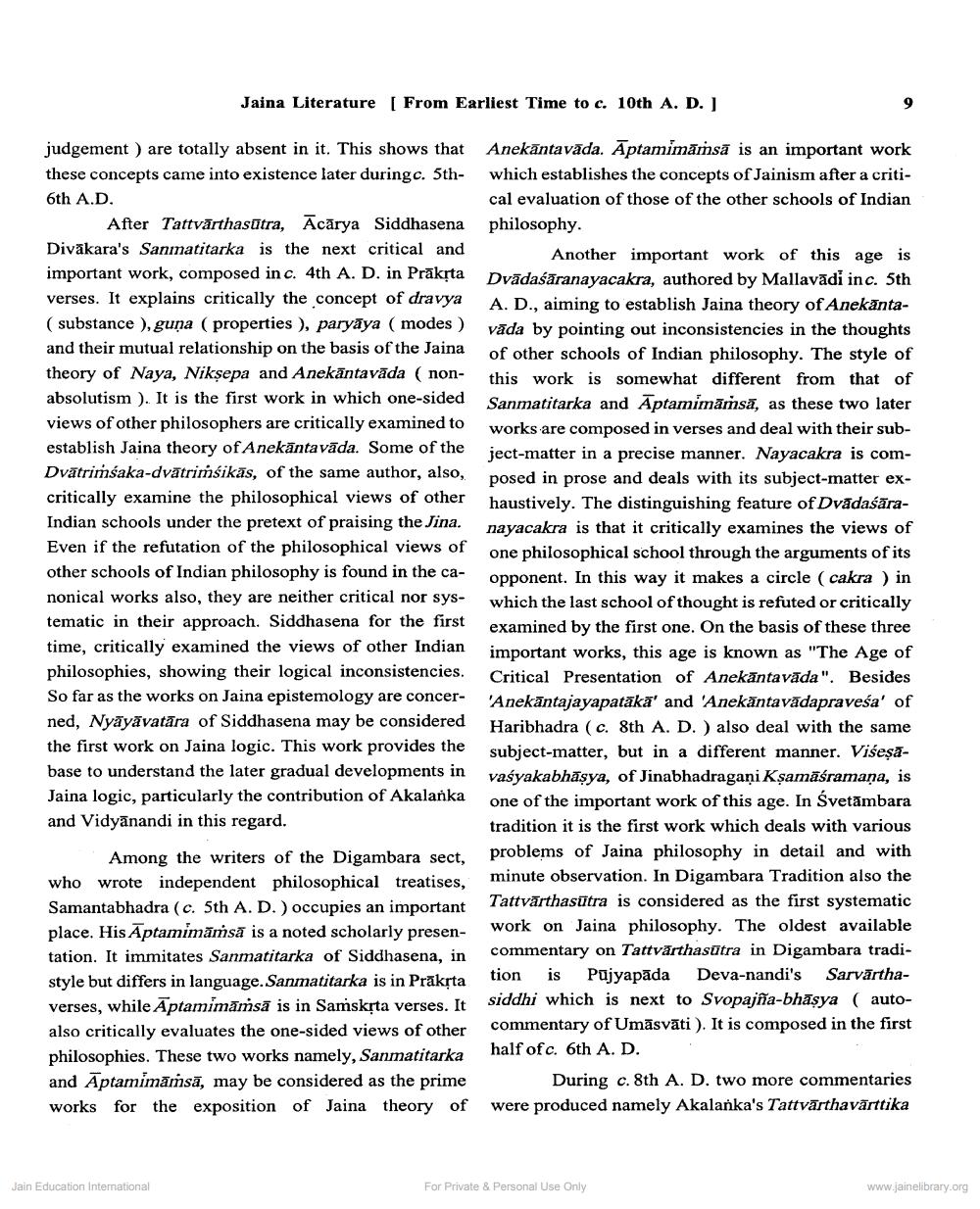________________
Jaina Literature (From Earliest Time to c. 10th A. D. ]
judgement ) are totally absent in it. This shows that these concepts came into existence later duringc. 5th- 6th A.D.
After Tattvārthasūtra, Ācārya Siddhasena Divākara's Sanmatitarka is the next critical and important work, composed in c. 4th A. D. in Prakrta verses. It explains critically the concept of dravya (substance ), guna (properties ), paryāya (modes) and their mutual relationship on the basis of the Jaina theory of Naya, Niksepa and Anekāntavāda (nonabsolutism ). It is the first work in which one-sided views of other philosophers are critically examined to establish Jaina theory of Anekāntavāda. Some of the Dvātrimsaka-dvatrimsikäs, of the same author, also, critically examine the philosophical views of other Indian schools under the pretext of praising the Jina. Even if the refutation of the philosophical views of other schools of Indian philosophy is found in the canonical works also, they are neither critical nor systematic in their approach. Siddhasena for the first time. critically examined the views of other Indian philosophies, showing their logical inconsistencies. So far as the works on Jaina epistemology are concer- ned, Nyāyāvatāra of Siddhasena may be considered the first work on Jaina logic. This work provides the
gic. This work provides the base to understand the later gradual developments in Jaina logic, particularly the contribution of Akalanka and Vidyānandi in this regard.
Anekāntavāda. Aptamimāmsā is an important work which establishes the concepts of Jainism after a critical evaluation of those of the other schools of Indian philosophy.
Another important work of this age is Dvādaśāranayacakra, authored by Mallavādi inc. 5th A. D., aiming to establish Jaina theory of Anekantavāda by pointing out inconsistencies in the thoughts of other schools of Indian philosophy. The style of this work is somewhat different from that of Sanmatitarka and Aptamimāṁsā, as these two later works are composed in verses and deal with their subiect-matter in a precise manner. Nayacakra is composed in prose and deals with its subject-matter exhaustively. The distinguishing feature of Dvadaśāranayacakra is that it critically examines the views of one philosophical school through the arguments of its opponent. In this way it makes a circle (cakra ) in which the last school of thought is refuted or critically examined by the first one. On the basis of these three important works, this age is known as "The Age of Critical Presentation of Anekantavāda". Besides 'Anekantajayapatākā' and 'Anekantavādapraveśa' of Haribhadra (c. 8th A. D. ) also deal with the same subject matter, but in a different manner. Višeşavasyakabhāşya, of Jinabhadragani Kşamāśramana, is one of the important work of this age. In Svetāmbara tradition it is the first work which deals with various problems of Jaina philosophy in detail and with minute observation. In Digambara Tradition also the Tattvārthasūtra is considered as the first systematic work on Jaina philosophy. The oldest available commentary on Tattvārthasūtra in Digambara tradition is Pajyapāda Deva-nandi's Sarvārthasiddhi which is next to Svopajña-bhāsya ( autocommentary of Umāsvāti). It is composed in the first half of c. 6th A. D.
During c. 8th A. D. two more commentaries were produced namely Akalanka's Tattvārtha vārttika
Among the writers of the Digambara sect, who wrote independent philosophical treatises, Samantabhadra (c. 5th A. D.) occupies an important place. His Aptamimāṁsā is a noted scholarly presentation. It immitates Sanmatitarka of Siddhasena, in style but differs in language. Sanmatitarka is in Prakrta verses, while Aptamimāṁsā is in Samsksta verses. It also critically evaluates the one-sided views of other philosophies. These two works namely, Sanmatitarka and Aptamimāṁsā, may be considered as the prime works for the exposition of Jaina theory of
Jain Education International
For Private & Personal Use Only
www.jainelibrary.org




